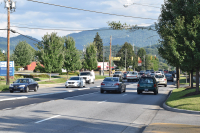Abbey’s tenure at ‘Redneck U’
Radical ecologist and writer Edward Abbey (1927-1989) was born in Home, Penn., the son of a hardscrabble farmer and a schoolteacher. Hitchhiking as an adolescent through the western United States initiated a lifelong identity with that region. After being discharged from the U.S. Army in 1947, Abbey worked at various marginal jobs while studying philosophy at the University of New Mexico, from which he earned B.A. and M.A. degrees. The title of his master’s thesis was “Anarchism and the Morality of Violence.”
Abbey worked in the western states, intermittently, as a U.S. Forest Service fire-lookout and for the National Park Service as a ranger. He also, without success, tried his hand at being a social caseworker and technical writer in New York City. He wrote eight novels, seven collections of non-fiction prose, a gathering of aphorisms, the texts for five collections of photographs, and — for just for good measure — he self-edited The Best of Edward Abbey. Later in life, he taught writing at the University of Arizona. He was married three times.
According to Kingsley Widmer’s biographical sketch in American National Biography Online, “Abbey held that his main vocation was as iconoclastic literateur defending natural wilderness and freedom. [His] best-known novel, and intended handbook of troublemaking, The Monkey-Wrench Gang (1975), along with its posthumously published continuation Hayduke Lives! (1990), is dedicated to the “Luddite anarchism of sabotaging American technocracy in the remaining open West.”
Abbey’s best writing occurs in his non-fictional prose narratives and essays. The most famous of these is Desert Solitaire: A Season in the Wilderness (1968). Widmer notes that it “centers with tough candor on his times as a fire-lookout and park ranger. Here, and increasingly in later essays ... he revived anarchist Propaganda of the Deed (destroying surveyors’ markers, burning billboards, disabling diesels, protectively tree-spiking in old-growth forests, satiric sloganeering, and other measures) .... But in fact Abbey was more of a sardonic commentator than a political activist. [His] self-conscious role was to combine, in both person and writings, the ecologically sensitive wilderness westerner with the Enlightenment rebel-skeptic in a post-World War II he-man manner (he had trouble with “new feminism” and other “chicken-xxxx liberalism”).
“In spite of his considerable macho western mode — including boots and vest over flannel shirt, six-pack of beer and cigar, pickup and .357 magnum, full beard and fully scornful tongue — he was also attempting a libertarian revision of western mythology.”
Be that as it may, when he got around to doing so, Abbey could write with beautiful insight about the landscapes and entities in the natural world that he encountered. Some of his finest nature writing appears in an essay titled “Natural and Human History,” which served as the text for Appalachian Wilderness: The Great Smoky Mountains — a coffee-table size book published in 1970 that featured the photographs of Eliot Porter.
Related Items
Abbey was chosen to prepare this text because he had proven his ability as a writer of descriptive prose with Desert Solitaire. And he could also point out that he had resided within 30 miles of the Great Smoky Mountains National Park for a short while in 1968. As he was departing from the Great Smokies after completing his writing-assignment visit in 1969, he noted, in passing, that, “We come next to Sylva, where I had lived the year before while teaching at nearby University of Western North Carolina.” That’s the short version of an interesting interlude in Abbey’s career.
A fuller version is provided in James M. Cahalan’s Edward Abbey: A Life (2001). Abbey felt the need for a full-time job after his wife, Judy, had given birth to their daughter, Susannah. So, he accepted a position in the English Department at Western Carolina University, where a friend, Al Sarvis, was teaching in the Art Department.
According to Callahan, “Ed, Judy, and baby Susie lived in the nearby town of Sylva, in the basement of the rambling home of Marcellus Buchanan, a colorful local politician ... Abbey hated this area and his job. He noted on Oct. 8, 1968, that ‘like a bloody idiot,’ he had accepted a teaching job ‘here at Redneck U. All for monetary greed ... $7,800, or almost $1,000 per working month, good wages for me.’ He dreaded the ‘horror the tedium the drudgery of academic life. ‘How I loathe it. All those pink faces in the classroom three xxxxxxx hours, five xxxxxxx days per week .... always there’s tomorrow’s xxxx to prepare, to read, to grade’ ... [His] first term as a full-time instructor of record was not an auspicious one ... His English Department colleague D. Newton Smith explained that Abbey was ‘very shy about that process. He didn’t know what to do, pretty much.’ Smith added that Abbey’s training in philosophy, ‘a very contemplative kind of thing,’ was certainly ‘not the same thing as teaching English.’
“On wild drunken, reckless drives through the countryside, Abbey threw his homebrew bottles out the window and raged against the ugly billboards defacing the landscape ... When Abbey got the word that he could return to Organ Pipe [Cactus National Monument] for a second full season, he was so eager to flee the classroom and the coming Appalachian winter for the Arizona desert that he quit his teaching job before the end of the quarter ... Newt Smith clarified that ‘he simply gave everybody in his class a B and left. It was not well received!’”
Edward Abbey couldn’t (or wouldn’t) teach English, but he could write it. A year later he described this moment during a wintertime journey to Clingmans Dome:
“Higher and higher we rise toward the clouds, the cloud forest. We reach a certain elevation, about 4,500 feet, where all of the trees are covered with a delicate, brilliant, impeccable snowy lace. Not snow, not ice, but frozen fog, that’s what it is ... Brittle and fragile crystals of frost. Apparently the needles act as condensation nuclei, around which the cloud vapors gather and freeze. The effect is stranger than that of snow or ice; each tree, seen against the sun, seems to glow, to radiate an aura of intense white light.”
George Ellison wrote the biographical introductions for the reissues of two Appalachian classics: Horace Kephart’s Our Southern Highlanders and James Mooney’s History, Myths, and Sacred Formulas of the Cherokees. In June 2005, a selection of his Back Then columns was published by The History Press in Charleston as Mountain Passages: Natural and Cultural History of Western North Carolina and the Great Smoky Mountains. Readers can contact him at P.O. Box 1262, Bryson City, N.C., 28713, or at This email address is being protected from spambots. You need JavaScript enabled to view it..









